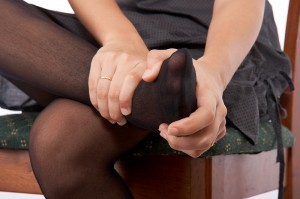
PRP Can Heal Plantar Fasciitis & Foot Pain
Foot pain is common in the United States. Approximately 1 out of 5 Americans suffer from foot pain. Frequently they are found to have heel spurs which cause pain. Associated with heel spurs is plantar fasciitis. Plantar fasciitis is an inflammation of the main supporting structure on the bottom of the foot. The plantar fascia attaches to the back of the foot at the heel bone. When there is increase tension and inflammation on the plantar fascia, it pulls on the heel bone, causing a heel spur to form. This heel spur then causes additional foot pain.
Foot pain comes from the inflamed plantar fascia but also from the heel spur itself. These conditions can be difficult to effectively treat. Many therapies can be tried including massage, orthotics, steroid injections and acupuncture. Fortunately, the majority of patients will get better within a year. For patients with heel spurs on x-ray studies, ultrasound shock wave therapy has been tried on some to break up the spur. Despite these treatments, 10-15% still experience persistent foot pain. As a last resort, some undergo surgery for plantar fasciitis. Unfortunately, this procedure has limited effectiveness, not always achieving the desired pain free outcome. Additionally, foot surgery carries with it a significant potential for complications such as infection or worsening pain.
Platelet rich plasma (PRP) therapy is a unique, new approach to patients plagued with foot pain and plantar fasciitis. It has the advantage of not requiring any surgery or time consuming therapies. PRP therapy is made using your own blood. About two ounces of your blood is drawn and put into a special centrifuge. The PRP is then drawn off into a syringe. PRP is injected into the bottom of the foot (after local anesthesia), in the area of where the plantar fascia attaches to the heel. Ideally, the PRP is injected around the heel spur area.
After PRP is injected, natural healing occurs over the next 6-8 weeks. There is no down time, recovery period or rehabilitation. Clinical experience in treating patients with persistent foot pain or plantar fasciitis, that has not responded to more conservative therapies, has been excellent. Lasting pain relief and healing occurs in well over 90% of the PRP-treated patients.
Some patients have partially torn or severely inflamed plantar fascia, in one or both feet. Platelet rich plasma therapy greatly assists in healing this damage tissue, repairing the torn fascia and tendons — all resulting in eliminating foot pain and reduction in painful heel spurs.
There is hope for many patients suffering from persistent foot pain, heel spurs and/or plantar fasciitis. Many will get better with standard conservative therapies. For those that have persistent pain, platelet rich plasma therapy is an ideal treatment. PRP has a proven effectiveness, extremely low risk and avoids surgery or narcotics. If you have persistent foot pain, PRP may be the treatment you are looking for.
If you have bothersome foot pain that has not responded to treatment and you are considering this natural, medically-advanced, non-surgical therapy, PRP Sarasota may be for you. In Sarasota, PRP therapy is available at Sarasota Neurology. This is an in-office procedure that eliminates the need for surgery and rehabilitation. In one hour, the procedure can be performed and you have no recovery time. If you think you may be a candidate for platelet rich plasma therapy, visit PRPStopsPain.com.
